#Battroid Gerwalk Valkyrie
Explore tagged Tumblr posts
Text

#Battroid Gerwalk Valkyrie#VF-1S Valkyrie#Valkyrie#VF-1S#Macross#model kit#box art#over art#art#design#mecha#mech#マクロス#超時空要塞マクロス#character design
208 notes
·
View notes
Text

VF-1 Valkyrie by Zero Bullets Left !?
93 notes
·
View notes
Text

I posted 33 times in 2022
33 posts created (100%)
0 posts reblogged (0%)
I tagged 27 of my posts in 2022
Only 18% of my posts had no tags
#youtube - 16 posts
#hobbyph - 6 posts
#marvel - 2 posts
#geekdom - 2 posts
#actionfigures - 2 posts
#fandom - 2 posts
#transformers - 2 posts
#nerddom - 2 posts
#womensmonth - 2 posts
#barbie - 2 posts
Longest Tag: 25 characters
#marvel cinematic universe
My Top Posts in 2022:
#5
#BlackPanther #WakandaForever #MarvelLegends Namor, Attuma BAF, #MortalKombat Kotal Kahn #HasbroPulse #McfarlaneToys

2 notes - Posted November 26, 2022
#4

TBT The Blue TShirt #SendMeBackSaturday #MastersOfTheUniverse #Teela #MOTU #SheWoman #Barbie #WomensMonth #Nerddom #Geekdom #Fandom #Hobbyph https://www.instagram.com/p/Cas65o8hbA_/?utm_medium=tumblr
2 notes - Posted March 5, 2022
#3

TBT The Black TShirt #FlashbackFriday #Transformers #Arcee #Autobots #Fembots #Barbie #WomensMonth #Nerddom #Geekdom #Fandom #Hobbyph https://www.instagram.com/p/CaplGSXBnmM/?utm_medium=tumblr
2 notes - Posted March 3, 2022
#2
#Plamax 1/20 scale #Macross #Robotech #VF1 #SkullSquadron Super/Strike Valkyrie Gerwalk Battroid anyone? #Hobbyph


3 notes - Posted November 23, 2022
My #1 post of 2022
#Transformers #G1 #Jazz is #OptimusPrime's right-hand bot. Unlike #Prowl, the #Autobots' military strategist, he responds well to change and improvisation. His position as Special Operations head calls for all the skills he possesses, yet he still has time to add some style to everything he does. #Hobbyph #Hasbro
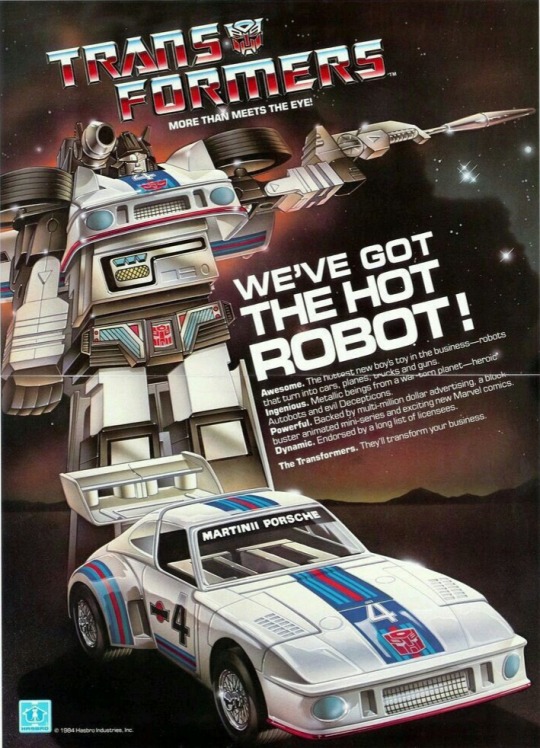
4 notes - Posted November 23, 2022
Get your Tumblr 2022 Year in Review →
1 note
·
View note
Photo

Esta figura es de esas rarezas de ver. Es copia de un molde de un VF-1 Valkyrie de Macross en una calidad de plástico decente y que cumple con los tres modos del caza, tiene algunos detalles como no ajustar las piezas de piernas y brazos en modo Jet para que queden sueltas, o el espacio para colocar el arma, pero aún así es muy cumplidor para costar 12 USD. #bootleg #macross #valkyrie #battroid #gerwalk #mecha #hobby #coleccionismo #actionfigures #figurasdeaccion https://www.instagram.com/p/B6UNXD4A8S_/?igshid=1rj0vr5xgw8rb
0 notes
Text
Movie-Exclusive Valkyrie from Macross Delta Will Become a DX Chogokin Figure

Macross Delta the Movie: Absolute Live!!!!!! premiered earlier this month in Japan, carrying on the story of the latest series in the sci-fi franchise. Among other reveals, Mirage Farina Jenius got to pilot a new Valkyrie. And early next year, you can get your hands on it, too — in figure form, that is.
The VF-31AX Kairos Plus will join the DX Chogokin line, a Macross-centric sub-series of Bandai's hefty, transformable Chogokin mecha figure series.

The Valkyrie stands approximately 260mm tall in its Battroid formation and comes with alternate left and right hands, melee knives, gun pods, a pilot figure, and a display stand. Just like the real thing in the series, this Valkyrie can be transformed between Battroid, GERWALK, and Fighter modes:


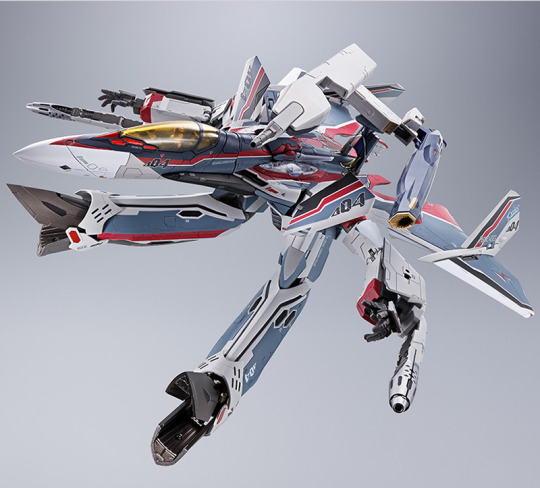


The VF-31AX Kairos Plus (Mirage Farina Jenius version) goes on sale for 23,000 yen (excluding tax) in March 2022. Hayate Immelman's Valkyrie will also be on sale starting in December, with a special display pedestal for early buyers.
Source: Anime! Anime!


By: Kara Dennison
1 note
·
View note
Text
Every time I see the Macross Valkyries I wonder why there even is a Battroid mode when GERWALK mode is basically the ideal mecha.
1 note
·
View note
Photo

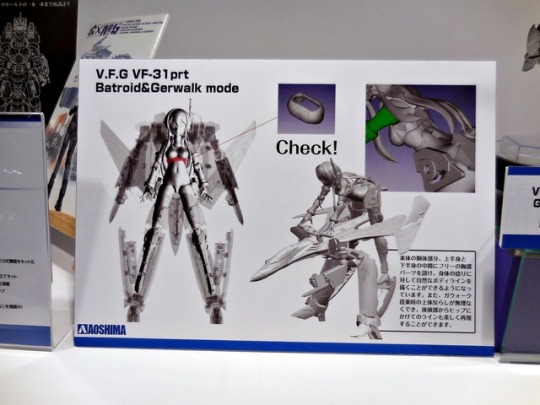

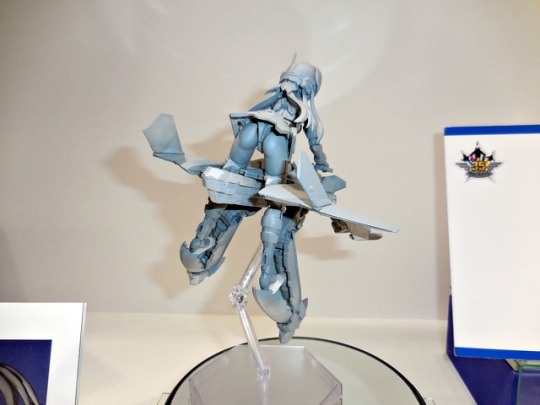
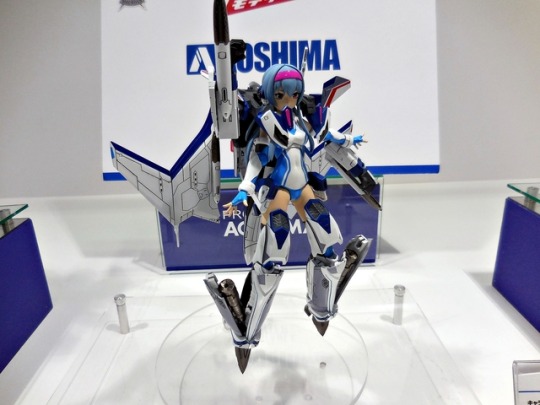
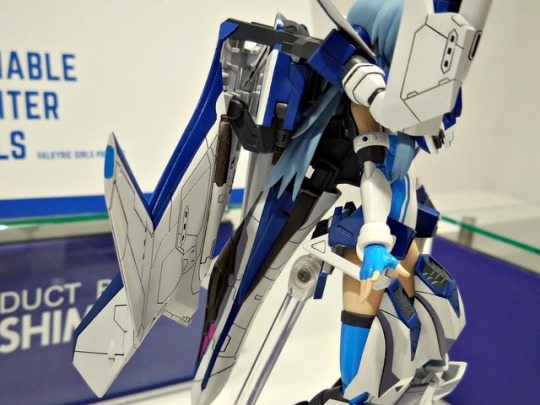
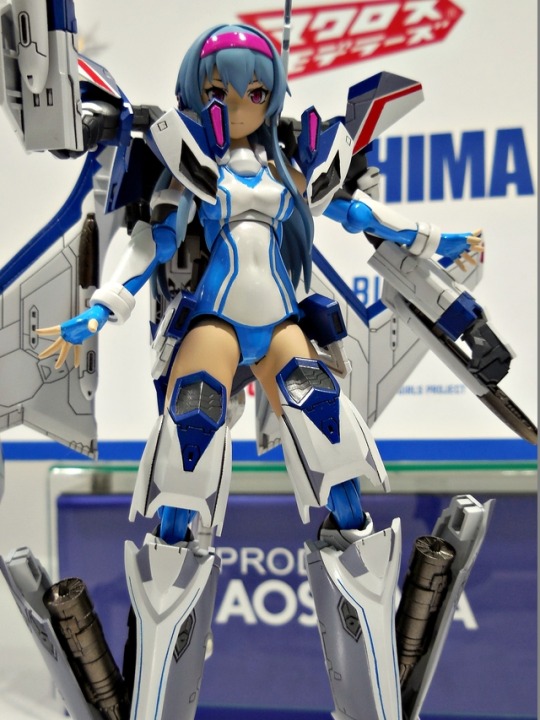
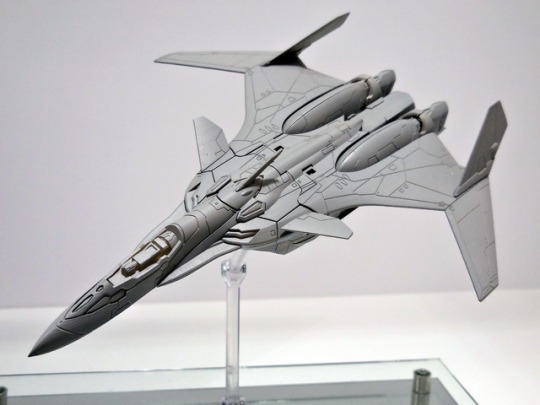
Aoshima 1:12 Macross Variable Fighter Girl 2017 All-Japan Model Hobby Show
Similar to Kotobukiya’s wildly popular Frame Arms Girls, this Macross Variable Fighter Girl is a 1:12 scale figure and a non-scale VF-31 Valkyrie fighter from Macross Delta that she can ride in Gerwalk mode and can become her frame armor as Battroid mode. Very neat! It should be out by spring 2018.
45 notes
·
View notes
Photo
Super Dimension Fortress Macross
My dad had that Skull Leader Valkyrie model. You could convert between fighter, GERWALK/Guardian (plane with arms and legs), and Battroid/Battloid (humanoid mecha) modes, and IIRC there was a blast shield that could slide down to cover the cockpit. Those metal plates on the shins were spring-loaded landing gear.

Takatoku catalog
35 notes
·
View notes
Text
Macross +++ 1:72 Stonewell/Belcom VF-4A “Lightning III”, aircraft “(7)01 Red” of the VAT-127 “Zentraedi Busters” aggressor squadron; personal mount of Flight Leader Maxim Dadashov; Choir Flight Academy, Mongolia, 2016 (WAVE kit)
Some background: ]The VF-4 Lightning III began development in 2005 under the initial designation of the VF-X-4. Developed as a successor craft to the VF-1 Valkyrie, the VF-4 Lightning III was designed as a variable fighter that emphasized mobility in outer space.
The VF-4’s development began with the prototype VF-X-4 and the VF-X-3. However, when Earth was devastated in Space War I the loss of military facilities also resulted in loss of the VF-X-3. Amongst the airframes under development exist prototype No. 1 craft, VF-X-4V1 and the trial manufactured VF-4A-0 and thus the surviving VF-X-4 was developed and completed as the VF-4 Lightning III. A trial-produced variable fighter, designated the VF-4A-0, was also built using 25% VF-1 Valkyrie parts.
VF-X-4 underwent flight tests, including being test piloted by Space War I veteran Hikaru Ichijo. Once successful operational models were ready, the VF-4 began mass production on February 2012. Initial deployment began on the SDF-2 Megaroad-01 in VF-1 Skull and SVF-184 Iron Chiefs Squadrons on September 2012. When the SDF-2 Megaroad launched in the same month, Hikaru Ichijō flew a VF-4 alongside the new colonization vessel as the ship lifted from Earth and began exploration outside of the Sol system.
As a result of integrating existing Overtechnology and Zentradi-series technology, the VF-4 had a characteristic three-hulled-type airframe structure remarkably different from the conservative VF-1 Valkyrie design. The three-hulled style of the VF-4 increased fuselage volume, propellant capacity and armament load capability that all resulted in a 40% improved combat ability over the VF-1. Fully transformable, the VF-4 could shift into Battroid and Gerwalk modes like previous variable fighters.
However, the VF-4 did suffer minor mobility problems within an atmosphere and the new type was primarily deployed to the Space Air Corps of emigrant fleets to serve as the main fighter craft of the UN Forces in the 2020s. It was because flight performance within the atmosphere was not as good as the VF-1 that the VF-5000 Star Mirage became the main combat craft within atmosphere, while the VF-4 operated mainly in outer space.
Built as a space fighter, the VF-4 primary weapons became two large beam cannons, though the craft was capable of carrying a GU-11 gun pod in Gerwalk and Battroid modes. In addition to the powerful primary beam guns, the Lightning III also featured twelve semi-recessed long-range missiles, as well as underwing pylons for additional missiles and other stores. The VF-4 was only slightly heavier than the VF-1, but featured considerably more powerful engines, making the craft ideal for operations deeper out in space. The Lightning III was also much faster in the atmosphere than the older VF-1, although the VF-4’s flight mobility performance was not as great.
The VF-4 was also notable as the first production variable fighter to utilize a HOTAS system (Hands On Throttle And Stick) for the cockpit HMI (Human-Machine Interface). Furthermore, the VF-4’s cockpit was laid out as a single hexagonal MFD (Multi-Function Display) that proved so successful that it was retrofitted into "Block 6" VF-1 fighters, as well as providing the template for all future variable fighter cockpits.
By the end of 2015, mass production of the VF-1 series at last had come to an end. From 2020 onward, the VF-4 Lightning III officially replaced the VF-1 to become the main variable fighter of U.N. Forces. Production of the VF-4 continued for a decade and ceased in 2022, with a total of 8,245 Lightning III variable fighters produced. The VF-4 variable fighter remained in active service into the late 2040’s but was complemented or substituted in many branches of the UN Forces by the cheaper and more atmospherically maneuverable VF-5000 Star Mirage. The VF-4 Lightning III was eventually replaced as the main variable fighter of U.N. Spacy in the later half of the 2030s by the VF-11 Thunderbolt.
General characteristics: Manufacturer: Stonewell/Bellcom Equipment Type: Variable fighter Government: U.N. Spacy, U.N. Space Marines Introduction: 2012 Operational Deployment: September 2012
Dimensions: Accommodation: pilot only Fighter Mode: wingspan 12.65 meters; height 5.31 meters; length 16.8 meters Mass: empty 13.95 metric tons Structure: space metal frame, SWAG energy conversion armor
Powerplant: 2x Shinnakasu/P&W/Roice FF-2011 thermonuclear turbine engines, rated at 14,000 kg (137.34 kN) each 2x dorsal rocket engines (mounted on top of the main thermonuclear turbine engines) 2x ramjet engines (embedded into the inner wing sections) P&W HMM-1A high-maneuverability vernier thrusters
Performance: Fighter Mode: Mach 3.02 at 10,000 m Mach 5.15 at 30,000+ m Thrust-to-weight ratio: (empty) 2.01 (rating for turbine engine thrust ONLY) g limit: unknown
[Armament: 2 x large beam cannons in forward engine nacelles 12x semi-recessed long range missiles (mounted on engine nacelles and ventral fuselage) 8x underwing pylons for missiles, gun pods an/or drop tanks
The kit and its assembly: Well, this build has been lingering for almost 25 years in the back of my mind. It just took so long that a suitable IP kit (with a reasonable price tag) would materialize! The original inspiration struck me with a VF-4 profile in the source book "This is animation special: Macross PLUS" from 1994, which accidently fell into my hands in a local Japanese book store. Among others, a side and top view profile of an aggressor VF-4 in an all-brown, Soviet-style paint scheme was featured. At that time I found the idea and the scheme pretty cool, so much that I even built a modified 1:100 VF-1 as a ground attack aircraft in this paint scheme.
However, the original VF-4 profile from the source book had always been present, but for years there had been no affordable kit. There have been garage/resin kits, but prices would start at EUR 250,-, and these things were and are extraordinarily rare. Things changed for the better when WAVE announced an 1:72 VF-4 kit in late 2016, and it eventually materialized in late 2017. I immediately pre-ordered one from Japan (in a smart move, this even saved money) and it eventually turned up here in Germany in early 2018. Patience pays out, it seems… I had preferred a 1:100 kit, though, due to space issues and since almost any other Macross variable fighter model in my collection is in this small scale, but I am happy that a decent VF-4 kit at all appeared after so many years!
Concerning the WAVE kit, there’s light and shadow. First of all, you have to know that you get a VF-4A. This is mentioned nowhere on the box, but might be a vital information for hardcore modelers. The early VF-4A is a rather different aircraft than the later VF-4G, with so fundamental differences that it would warrant a completely new kit! On the other side, with a look at the kit’s parts, I could imagine that a VF-4B two-seater could be easily realized in the future, too.
The kit is a solid construction, a snap-fit kit molded in different colors so that it can be built without painting. This sounds toy-like, but – like many small scale Bandai Valkyrie kits – anything you ask for is actually there. When you use glue and put some effort into the kit and some donor parts, you can make a very good model from it.
The kit’s box is pretty oversized, though (any sprue is shrink-wrapped, horrendous garbage pile and wasted space!), and the kit offers just a single decal (water-slide decals, not stickers) option for a Skull Squadron VF-4A – AFAIK it’s Hikaru Ichijoe’s machine that appears in one of the Macross Flash Back 2012 music videos, as it escorts the SDF-02 “Megaroad” colonial ship after launch from Earth towards the center of our Galaxy.
The parts are crisply molded, and I actually like the fact that the kit is not as uber-engineered as the Hasegawa Valkyries. You can actually call the WAVE kit simple – but in a positive sense, because the parts number is reduced to a minimum, material strength is solid and the kit’s construction is straightforward. Fit is excellent – I just used some putty along the engine gondolas due to their complex shape, but almost anything else would either fit almost perfectly or just call for some sanding. Impressive!
Surface details etc. are rather basic, but very crisp and emphasized enough that anything remains visible after adding some paint. However, after all, this aircraft is just a fictional animation mecha, and from this perspective the kit is really O.K..
After building the kit I most say that it’s nothing that leaves you in awe, and for a retail price of currently roundabout EUR 50-70,- (I was lucky to get it for an early bird deal at EUR 40,-, but still pricey for what I got) the kit is pretty expensive and has some weaknesses:
The model comes with a decent (= simple) cockpit and a very nice and large pilot figure, but with no ordnance except for the semi-recessed long-range missiles (see below). The cockpit lacks any side consoles, floor or side wall details. If you put the pilot into the cockpit as intended, this is not a big issue, since the figure blocks any sight into the cockpit’s lower regions. However, the side sticks are molded into the pilot’s hands, so that you have to scratch a lot if you want to present the cockpit open and with an empty seat.
The landing gear is simple, too, and the wells are very shallow (even though they feature interior details). As a special feature, you can switch with some extra parts between an extended or retracted landing gear, and there are extra parts that allow the air intakes and some vectoring nozzles to be closed/extended for orbital operations. However, detail fetishists might replace the OOB parts with the landing gear from an 1:72 F-18 for an overall better look.
Provisions for underwing hardpoints are actually molded into the lower fuselage part (and could be punched/drilled open – another indication that more VF-4 boxings with extra sprues might follow?), but the kit does not come with any pylons or other ordnance than the dozen fuselage-mounted AAMs. Furthermore, the semi-recessed missiles are just that: you only get the visible halves of the only provided ordnance, which are simply stuck into slits on the model’s surface. As a consequence, you have to mount them at any rate – building a VF-4 for a diorama in which the missiles are about to be loaded would require massive scratch-building efforts and modifications.
Another problem indirectly arises when you put some effort into the kit and want to clean and pre-paint the missiles before assembly: every missile is different and has its allocated place on the VF-4 hull. The missiles are numbered – but only on the sprue! Once you cut them out, you either have to keep them painstakingly in order, or you will spend a long evening figuring out where which missile belongs! This could be easily avoided if the part number would be engraved on the missiles’ back sides – and that’s what I actually did (with a water-proof pen, though) in order to avoid trouble.
The clear canopy is another issue. The two parts are crystal-clear, but, being a snap-fit kit, the canopy parts have to be clipped into the fuselage (rear part) and onto a separate canopy frame (front part). In order to fit, the clear parts have cramps molded into their bases – and due to the excellent transparency and a magnifier effect, you can see them easily from the outside – and on the inside, when you leave the cockpit open. It’s not a pretty solution, despite the perfect fit of the parts. One option I can think of is to carefully sand the cramps and the attachment points away, but I deem this a hazardous stunt. I eventually hid the cramps behind a thin line of paint, which simulates a yellow-ish canopy seal. The extra windscreen framing is not accurate, but the simplest solution that hides this weak point.
The kit itself was built OOB, because it goes together so well. I also refrained from adding pylons and ordnance – even though you can easily hang anything from Hasegawa’s VF-1 weapon set under the VF-4’s wings and fuselage. A final, small addition was a scratched, ventral adapter for a 3.5 mm steel rod, as a display for the flight scene beauty pic.
Painting and markings: As mentioned above, the livery is based on an official profile which I deem authentic and canonical. My aircraft depicts a different machine from VFT-127, though, since I could not (and did not really want to) 100% replicate the profile’s machine from the Macross PLUS source book, "13 Red". Especially the squadron’s emblem on the fin would create massive problems.
For the two-tone wrap-around scheme I used Humbrol 72 (Khaki Drill) and 98 (Chocolate Brown), based on the printed colors in the source book where I found the scheme. The pattern is kept close to the benchmark profile, and, lacking an underside view, I just mirrored the upper scheme. The starboard side pattern was guesstimated. As a second-line aggressor aircraft, I weathered the VF-4 with a black ink wash, some post-shading with various lighter tones (including Humbrol 160, 168, 170 and 187) and did some wet-sanding treatment for an uneven and worn look.
Interior surfaces were painted according to visual references from various sources: the landing gear and the air intakes became white, while the cockpit was painted in RAF Dark Sea Grey.
In order to add some color to the overall brown aircraft I decided to paint the missiles all around the hull in white with tan tips – in the profile, the appear to be integrated into the camouflage, what I found dubious.
Most stencils come from the OOB sheet, but I added some more from the scrap box. The grey "kite" roundels come from an 1:72 Hasegawa Macross F-14 Tomcat kit sheet, which I acquired separately for a reasonable price. Even though it took four weeks to be delivered from Asia, the investment was worthwhile, since the sheet also provided some useful low-viz stencils.
The VAT-127 “Zentraedi Busters” unique tail insignia was more complicated, because these had to be printed at home. As a side note, concerning the fin marking, I recently found a translation of the benchmark profile’s text on mahq.net, which is interesting: "The Regult within the targeting reticle on the tail met with disapproval from micronized Zentraedi pilots, and so was only used for a short time." The comment also reveals that the original aircraft’s modex is "713", not just "13" as depicted, so I tried to reflect these details on my build, too.
I eventually settled for a solution that was partly inspired by the kit’s OOB fin marking and the wish for more contrast for the motif: I scanned the original Regult pod illustration from the source book and printed it on white decal sheet. This was sealed with two layers of glossy acrylic varnish (applied with a rattle can) and then cut into a white field that fills the fixed part of the fin (using the WAVE kit’s OOB fin markings as reference). Once in place and dry, two black outlines were added separately (generic decal material) which help blend the decal and the surroundings. Finally, thin strips of silver decal sheet were used for the fins’ leading edges.
This design variation, compared with the original “13 Red” illustration, led to the idea of a flight leader’s machine with slightly more prominent markings. In order to take this concept further I also gave the aircraft a white stripe around the front fuselage, placed under the kite roundel and again with black outlines for a consistent look. It’s not much different from “13 Red”, but I think that it looks conclusive and, together with the white fin markings and the missiles, livens up the VF-4’s look.
The appropriate flight leader tactical code “01 Red” was puzzled together from single digits from a Begemot Su-27 sheet, the rest of the bort numbers were taken from the OOB sheet (which incidentally feature a “01” code, too).
Concerning the OOB decal sheet, there’s much light but also some deep shadow. While the register is excellent and the carrier film flexible enough to lay down smoothly, the instructions lack information where to place the zillion of stencils (“No step” and “Beware of Blast” stuff) are to be placed! You only get references for the major markings – the rest has either to be guessed, OR you are in possession of the VF-4 source book from Softbank Publishing which was (incidentally?) released in parallel with the WAVE kit. This mecha porn offers an overview of all(!) relevant stencils on the VF-4A’s hull, and ONLY with this information the exhaustive decal sheet makes some sense…
As final steps, the VF-4 received some dry-brushing with light grey around the leading edges, some chipped paint was simulated with dry-brushed aluminum and, finally, light soot stains around the vectoring nozzles all around the hull and the weapon bays were created with graphite. Then the kit was sealed with matt acrylic varnish (Italeri).
Well, in the end, it’s not a carbon copy of the inspiring illustration, but rather another machine from the same squadron, with more creative freedom. I stayed as true to the benchmark as possible, though, and I like the result. Finally, after almost 25 years, I can tick this project off of my long ideas and inspiration list.
Considering the kit itself, I am really torn. I am happy that there finally is a VF-4 IP kit at all after so many years, but to me it’s a contradictive offer. I am not certain about the target group, because for a toy-like snap-fit kit it’s too detailed and expensive, but for the serious modeler it has some major flaws. The biggest issue is the kit’s horrendous price – even if it would be more detailed or contained some fine resin or PE parts (which I would not want, just a “good” plastic kit). Sure, you can put some effort into the kit and improve it, e .g. in the cockpit or with a donor landing gear, but weak points like the “flat” missiles and the lack of proper bays for them are IMHO poor. For the relatively huge price tag I’d hoped for a “better” OOB offer. However, the kit is easy to build and a good representation of the Lightning III, and I am curious if there are kit variants in WAVE’s pipeline?
Posted by dizzyfugu on 2018-06-09 15:34:26
Tagged: , wave , vf-4 , model , kit , wip , lightning , iii , macross , flash , back , 2012 , review , building , painting , anime , mecha , valkyrie , vat-127 , zentraedi , UN , spacy , desert , sand , brown , scheme , aggerssor , top , gun , training , fictional , aviation , vf-4a , this , is , animation , special , PLUS , choir , tschoir , mongolia , leader , flight , academy , fighter , interceptor , orbital , canard , wing , ramjet , red , star , regult , pod , emblem
The post Macross +++ 1:72 Stonewell/Belcom VF-4A “Lightning III”, aircraft “(7)01 Red” of the VAT-127 “Zentraedi Busters” aggressor squadron; personal mount of Flight Leader Maxim Dadashov; Choir Flight Academy, Mongolia, 2016 (WAVE kit) appeared first on Good Info.
0 notes
Text
#Plamax 1/20 scale #Macross #Robotech #VF1 #SkullSquadron Super/Strike Valkyrie Gerwalk Battroid anyone? #Hobbyph


5 notes
·
View notes